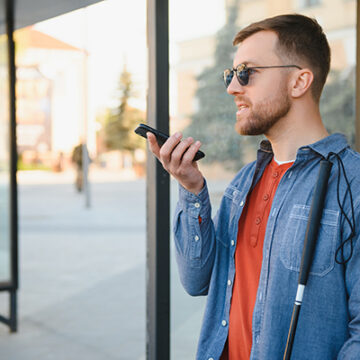News
Tech On the Go: Apps that Make Travel Easier
July 2, 2024

Posted by AbleNews
By Jeremy Morak, Marketing Manager, Lighthouse Guild
The summer is the perfect time to explore new neighborhoods and travel to new cities or countries. For people who are blind or visually impaired, navigating new destinations can pose potential challenges, but thanks to the advancement of assistive technology, traveling has never been easier or more accessible! You can stroll through cobblestone streets, feel the sun’s warmth on your face as you uncover hidden treasures, or visit a continent you’ve never been to—all with the help of your smartphone. Dr. Bryan Wolynski, Chief Technology Officer at Lighthouse Guild, highlights three navigation apps that are changing how blind and visually impaired individuals travel. Buckle up, place your seat in the upright position, and get ready to explore with confidence!
All of these apps are free to download. They use sound and vibration to safely guide users through outdoor environments. Keep in mind that there are apps such as GoodMaps and RightHear that support indoor navigation or orientation, but the following apps are more suited for outdoor traveling.
Lazarillo
Lazarillo is a specialized GPS app that provides way-finding guidance and mapping solutions for people who are blind or visually impaired. Using audio messages, Lazarillo will tell a user about landmarks or points of interest on their path, the street someone is walking on, and upcoming inter sections. Like a radio, Lazarillo will announce what’s around you while you are traveling and using the app. Users can customize how much information they want to receive while walking. For example, someone can specify that they only want to be informed about restaurants. The app will also assist user orientation by signaling which direction to turn before beginning the journey. For more information, visit https://lazarillo.app/
HapticNav
HapticNav operates through haptic technology, which uses vibration to guide users without the need of audio or visual guidance. Once a user inputs their travel destination, the app creates a route and guides the individual through a virtual corridor. If a person veers off course, either too far to the right or too far to the left, the phone will begin to vibrate, signaling to the user that they are no longer within the path. For more information, visit https:// haptic.works/
Oko
Oko provides turn-by-turn instructions via GPS but also uses audio and haptic feedback to alert the user to the status of pedestrian traffic signals. As you scan an intersection with your phone’s camera in a straight-ahead direction, the app uses different sounds based on whether the pedestrian signal indicates to stop or walk, and even provides a countdown. For more information, visit https://www.ayes.ai/
These apps can be powerful tools for people who are blind or visually impaired. However, people should rely first on their orientation and mobility training and use forms of technology as a secondary option. Navigation and orientation apps are revolutionizing how we move around the world but are not always one hundred percent accurate. The safest way to travel is to use all of the resources available. Nevertheless, navigation apps can help make traveling less stressful and more fun.
Join our Mission
Lighthouse Guild is dedicated to providing exceptional services that inspire people who are visually impaired to attain their goals.
